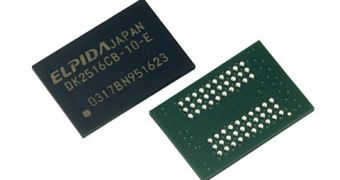Elpida Memory has announced today that it has successfully completed the development of a 2-gigabit Mobile RAM product, which takes advantage of the features delivered by the 50nm process technology, with a 193nm (ArF) immersion lithography. The company's new product has been specifically built to meet the requirements of current and upcoming mobile devices.
According to Elpida, the new ultra low-power features of Mobile RAM will be ideal for use in mobile phones, portable multimedia devices and portable Internet-capable devices, such as netbooks or MIDs. When developing the new memory, Elpida focused on delivering a product that could help consumers save energy, thus further expanding the battery life of the device in which the RAM would be used. When comparing the 70nm products with the new 50nm models, a 50 percent decrease in the data retention current should be noticed, as well as the usage of just half the operating current.
The new product is said to be capable of optimizing the pad layout for PoP (Package on Package), MCP (Multi Chip Package) and other packaging technology. Also, the RAM has been designed to address the need for smaller, yet higher capacity memory packages for use in mobile devices.
Elpida's RAM uses an x32-bit I/O configuration that is based on double-data rate (DDR) that can operate at fast speed of 400Mbps (200MHz), while the data transfer rate is expected to settle at 1.6 gigabytes per second. With these specifications, Elpida's product can meet the requirements of high-resolution, high-quality graphics display and high bandwidth video play. The Mobile RAM also supports both single-data rate (SDR) and more advanced DDR, and can be featured with either an x32 bit or x16 I/O configuration on a single-chip solution.
Elpida plans to have its product enter mass production in the first half of 2009.

 14 DAY TRIAL //
14 DAY TRIAL //